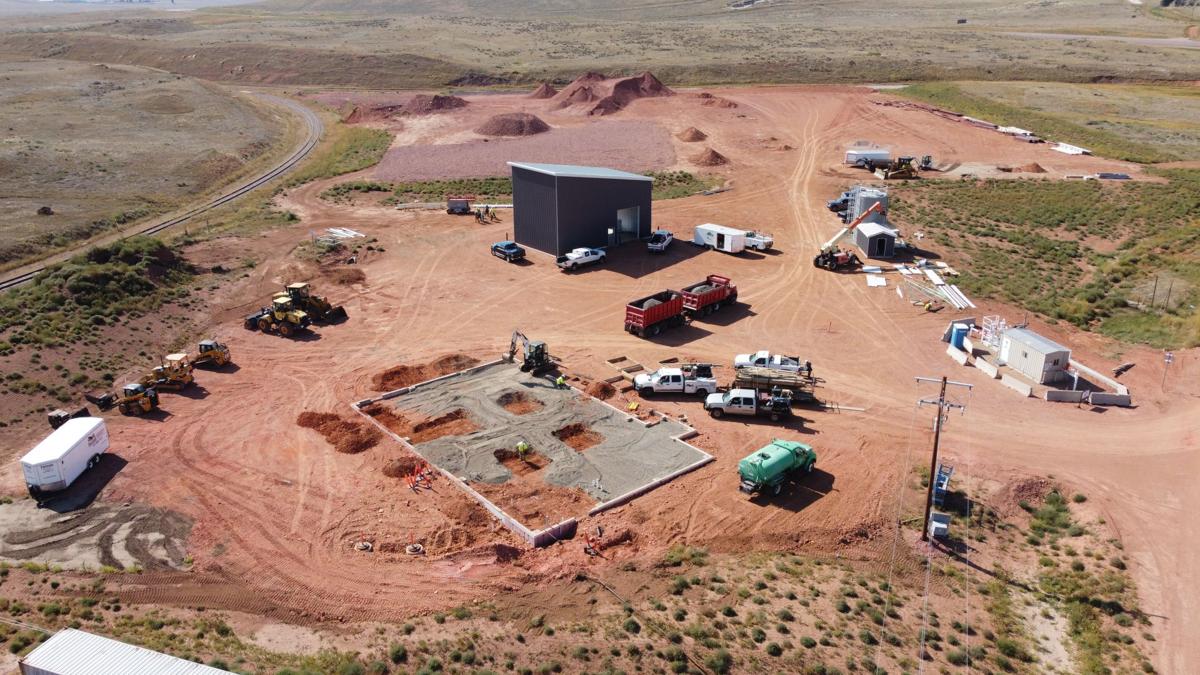Construction Underway on Coal-to-Products Facility in Wyoming

By Carrie Haderlie
October 25, 2021 - Construction on a large-scale facility that will be home to technology developers in coal-to-products research is well underway in Wyoming.
Officials broke ground in June on the Wyoming Innovation Center, located in the heart of the Powder River Basin. Built on 9.5 acres in the Fort Union industrial park, the WyIC will provide seven pads, or locations, where pilot plants can be built, operated and monitored.
The entire center is dedicated to developing advanced carbon products using coal and coal byproducts as the primary raw material, and is a “research-to-commercialization facility intended to accelerate research from lab level to pre-commercialization,” according to Energy Capital Economic Development, the economic development group for Campbell County and Gillette.
On site, a 4,000-square-foot building will provide office, lab and workspace for tenants, in addition to a 1,500-square-foot materials handling building, where incoming raw materials can be sized for the processes being evaluated. Lab research demonstrates the possibility of refining coal into products such as carbon fiber, asphalt, fuels of all types, activated carbon, char for agricultural use and other uses, according to the ECED. But, in many cases, the research has stayed in the lab and has never developed into marketable commercial products.

This drone image of the construction at the Wyoming Innovation Center shows an almost complete materials handling building, the foundation for the main building and the water tank and support building. In the background is site development for the pilot plant pads.
Photo courtesy of Energy Capital Economic Development
“One critical piece is needed: a place where these technologies can be proven out on a small, pre-commercial plant-size level,” the ECED said. “That is the purpose of the WyIC; to have a place where the lab research can be taken from the lab and proven to be commercially viable.”
The WyIC is several miles from the Integrated Test Center, which opened in May of 2018, and provides space for researchers to test carbon capture, utilization and sequestration technologies using actual coal-based flue gas.
“The Wyoming Innovation Center is going here in the Powder River Basin because this is where the coal is,” said Phil Christopherson, CEO Energy Capital Economic Development in Gillette. “It is easy enough to access coal here, and have it available for product projects that are scaling up. We won’t have to take it elsewhere, and, eventually, we are hoping that commercial facilities will actually work in the area to manufacture whatever product they decide.”
Between 2014 and 2016, Campbell County received visits from various businesses looking for a place to develop coal-to-product ideas, according to the ECED. At the time, officials were only able to show them bare ground, and the ECED began thinking in earnest about how Campbell County could be home to a facility that would take that research from the lab level to the pilot plant, then commercialization.
It took several years to secure funding through the Wyoming Business Council and the U.S. Department of Commerce Economic Development Administration for the WyIC project, and land purchases were made in 2019. Through the pandemic, design work continued until the groundbreaking this summer.
“Construction is moving along at a fairly rapid pace,” Christopherson said. “We’ve been impacted by the shortage of construction materials, but it has only slowed us down by a couple weeks. We’ve been pretty fortunate, because I know of other projects that are down by months.”
A drone shot of the construction at the Wyoming Innovation Center in September showed an almost complete materials handling building, a foundation for the main building and the water tank and support building, and site development for the pilot plant pads.
“All in all, it is going very well,” Christopherson said. “We should be complete with the entire facility probably by the end of December or the middle of January.”
The WyIC will not be a research facility, exactly, but will focus on the next level of coal-to-products development.
“We have done a lot of lab-level research covering coal integration products, so carbon fiber, activated carbon, asphalt … you can do it in a lab, but what we haven’t proven is a way to scale up the process to a commercial-sized process. We haven’t (asked), 'Can you do it and make it commercially viable, so you can make money making a product?'
“Our facility is going to fill that gap, to allow places to scale up their research, and prove that it is commercially viable,” Christopherson said. “Some of the technologies will prove to be commercially viable and some will not. That is why this facility exists.”
Holly Krutka, executive director of the School of Energy Resources at the University of Wyoming, said that once complete, her department will be a user of the facility.
“We’re working on a lot of different technologies to use coal for non-energy purposes, so we are looking at things like soil amendments, construction materials, asphalt additives and replacements, coatings … all kinds of stuff,” she said. “One of our big challenges, not just with that technology portfolio, but, in general, is where do we go when we need to move things out of the lab? The Wyoming Innovation Center is going to be a great platform for end users like SER, to be able to move out of the lab and have a bigger place to test their equipment.”
The School of Energy Resources will test at least part of its coal-to-products technology there, once complete, she added, and there will likely be other tenants, as well. Like at the Wyoming Integrated Test Center, access to natural resources and other utilities in the area will be a draw.
“There are things that are going to be offered that will be helpful for technology developers like the School of Energy Resources,” she said. “I think they’re reaching out to technology developers like us all across the country, and similar to the Wyoming Integrated Test Center, it will provide a platform for developers to test their technology.”
It does take time to recruit technology developers, but that investment is already paying off at the ITC, Krutka said. In April, the U.S. Department of Energy announced it would award Membrane Technology and Research Inc. $51 million to build and operate a large pilot membrane carbon capture system at the Wyoming Integrated Test Center.
“Quite frankly, there would be no other place Membrane Technology and Research would have to test. It is really hard to get access to flue gas and space like at the Integrated Test Center,” Krutka said. “The Wyoming Innovation Center is the same model, but on coal-to-products, so a different focus.”
Christopherson said the project’s biggest supporters have included Campbell County, the city of Gillette and the University of Wyoming School of Energy Resources. And, as always, the support stems from a desire to keep the region economically viable.
“We also see this as a job saver. If we continue to support the coal industry and provide a market for the product, that will help retain coal mining jobs,” Christopherson said. “We’re seeing new jobs coming along, plus a way to maintain existing jobs that are out there.”

